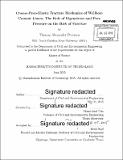Chemo-poro-elastic fracture mechanics of wellbore cement liners : the role of eigenstress and pore pressure on the risk of fracture
Author(s)
Petersen, Thomas Alexander
DownloadFull printable version (17.99Mb)
Other Contributors
Massachusetts Institute of Technology. Department of Civil and Environmental Engineering.
Advisor
Franz-Josef Ulm.
Terms of use
Metadata
Show full item recordAbstract
Between 2001 and 2010, United States natural gas wells have been drilled at a mean annual rate of 24,500. Moreover, an investigation in the Marcellus region revealed a 3.4% incidence rate of well-barrier leakages that were caused primarily by casing and cementing problems. Considering the detrimental consequences even a single failed well can have on the health of vast expanses of ecosystems, the quality of groundwater aquifers, and the production efficiency of fossil resources, ensuring the integrity of cement liners is of utmost importance. While much attention has been devoted to the mechanical analysis of the cement sheath during temperature and casing pressure cycles in the hardened state, modeling efforts of the early-age shrinkage and pore-pressure developments have thus far proved inadequate. This motivates us to study the cement sheath as a poro-elastic media under growth and stiffening of its solid structure, and connect bulk stress and pressure development to worst-case fracture scenarios. Specifically, a bottom-up approach is herein developed to incorporate the microscale behavior of the hydrating cement phases into a predictive risk-of-fracture model. We incorporate recent findings of the driving mechanism of eigenstress development in CSH-gel and connect it, via Levine's theorem, to pore-pressure changes in the sheath. Coupled to the boundary conditions of an inner steel casing and an outer rock formation, the bulk stress in the sheath is calculated incrementally with reference to the growing solid skeleton. The added risk due to the off-center placement of the casing is quantified in a novel Laurent series solution to the stress state. Finally, energy release rates are derived for (i) the micro-annulus formation along the steel-cement and rock-cement interfaces, and (ii) the occurrence of a single radial fracture emanating from the steel-cement interface.
Description
Thesis: S.M., Massachusetts Institute of Technology, Department of Civil and Environmental Engineering, 2015. Cataloged from PDF version of thesis. Includes bibliographical references (pages 185-194).
Date issued
2015Department
Massachusetts Institute of Technology. Department of Civil and Environmental EngineeringPublisher
Massachusetts Institute of Technology
Keywords
Civil and Environmental Engineering.